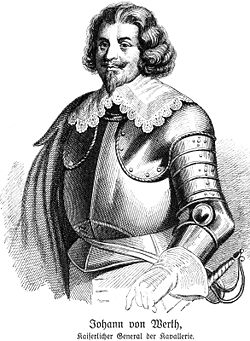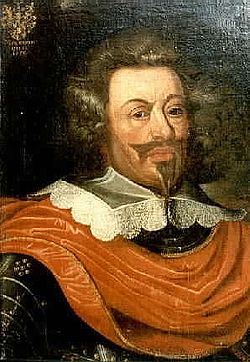
Johann von Werth
Encyclopedia

General
A general officer is an officer of high military rank, usually in the army, and in some nations, the air force. The term is widely used by many nations of the world, and when a country uses a different term, there is an equivalent title given....
of cavalry
Cavalry
Cavalry or horsemen were soldiers or warriors who fought mounted on horseback. Cavalry were historically the third oldest and the most mobile of the combat arms...
in the Thirty Years' War
Thirty Years' War
The Thirty Years' War was fought primarily in what is now Germany, and at various points involved most countries in Europe. It was one of the most destructive conflicts in European history....
.
Biography
He was born in 1591 at Büttgen in the duchy of JülichDuchy of Jülich
The Duchy of Jülich comprised a state within the Holy Roman Empire from the 11th to the 18th centuries. The duchy lay left of the Rhine river between the Electorate of Cologne in the east and the Duchy of Limburg in the west. It had territories on both sides of the river Rur, around its capital...
as the eldest son with eight more brothers and sisters. His parents (Johann von Wierdt (†1606) and Elisabeth Streithoven) belonged to the numerous class of the lesser nobility, and at an early age he left home to follow the career of a soldier of fortune in the Walloon cavalry of the Spanish service. In 1622, at the taking of Jülich, he won promotion to the rank of lieutenant. He served as a colonel of cavalry in the Bavaria
Bavaria
Bavaria, formally the Free State of Bavaria is a state of Germany, located in the southeast of Germany. With an area of , it is the largest state by area, forming almost 20% of the total land area of Germany...
n army in 1630. He obtained the command of a regiment, both titular and effective, in 1632, and in 1633 and 1634 laid the foundations of his reputation as a swift and terrible leader of cavalry
Cavalry
Cavalry or horsemen were soldiers or warriors who fought mounted on horseback. Cavalry were historically the third oldest and the most mobile of the combat arms...
forays. His services were even more conspicuous in the great pitched Battle of Nördlingen (1634)
Battle of Nördlingen (1634)
The Battle of Nördlingen was fought on 27 August or 6 September , 1634 during the Thirty Years' War. The Roman Catholic Imperial army, bolstered by 18,000 Spanish and Italian soldiers, won a crushing victory over the combined Protestant armies of Sweden and their German-Protestant allies .After...
, after which the emperor made him a Freiherr of the Empire, and the elector of Bavaria gave him the rank of lieutenant field-marshal. About this time he armed his regiment with the musket
Musket
A musket is a muzzle-loaded, smooth bore long gun, fired from the shoulder. Muskets were designed for use by infantry. A soldier armed with a musket had the designation musketman or musketeer....
as well as the sword
Sword
A sword is a bladed weapon used primarily for cutting or thrusting. The precise definition of the term varies with the historical epoch or the geographical region under consideration...
.

Lorraine (province)
The Duchy of Upper Lorraine was an historical duchy roughly corresponding with the present-day northeastern Lorraine region of France, including parts of modern Luxembourg and Germany. The main cities were Metz, Verdun, and the historic capital Nancy....
and Luxembourg
Luxembourg
Luxembourg , officially the Grand Duchy of Luxembourg , is a landlocked country in western Europe, bordered by Belgium, France, and Germany. It has two principal regions: the Oesling in the North as part of the Ardennes massif, and the Gutland in the south...
, after which he projected an expedition into the heart of France. Starting in July 1636, from the country of the lower Meuse
Meuse River
The Maas or Meuse is a major European river, rising in France and flowing through Belgium and the Netherlands before draining into the North Sea...
, he raided far and wide, and even urged the cardinal infante, who commanded in chief, to "plant the double eagle on the Louvre
Louvre
The Musée du Louvre – in English, the Louvre Museum or simply the Louvre – is one of the world's largest museums, the most visited art museum in the world and a historic monument. A central landmark of Paris, it is located on the Right Bank of the Seine in the 1st arrondissement...
." Though this was not attempted. Worth's horsemen appeared at Saint-Denis before the uprising of the French national spirit in the shape of an army of fifty thousand men at Compiègne
Compiègne
Compiègne is a city in northern France. It is designated municipally as a commune within the département of Oise.The city is located along the Oise River...
forced the invaders to retire whence they had come. The memory of this raid lasted long, and the name of "Jean de Wert" figures in folk-songs and serves as a bogey to quiet unruly children.
In 1637 Werth was once more in the Rhine valley, destroying convoys, relieving besieged towns and surprising the enemy's camps. In February 1638 he defeated the Weimar troops in an engagement at Rheinfelden
Rheinfelden
Rheinfelden is a municipality in the canton of Aargau in Switzerland, seat of the district of Rheinfelden. It is located 15 kilometres east of Basel. The name means the fields of the Rhine, as the town is located on the Hochrhein. It is home to Feldschlösschen, the most popular beer in...
, but shortly afterwards was made prisoner by Bernhard of Saxe-Weimar
Bernhard of Saxe-Weimar
Bernard of Saxe-Weimar was a German prince and general in the Thirty Years' War.-Biography:Born in Weimar within the Duchy of Saxe-Weimar, Bernard was the eleventh son of Johann, Duke of Saxe-Weimar, and Dorothea Maria of Anhalt.Bernard received an unusually good education and studied at the...
. His hopes of being exchanged for the Swedish
Sweden
Sweden , officially the Kingdom of Sweden , is a Nordic country on the Scandinavian Peninsula in Northern Europe. Sweden borders with Norway and Finland and is connected to Denmark by a bridge-tunnel across the Öresund....
field marshal Gustaf Horn were disappointed for Bernhard had to deliver up his captive to the French. The terrible Jean de Wert was brought to Paris, amidst great rejoicings from the country people. He was lionized by the society of the capital, visited in prison by high ladies, who marvelled at his powers of drinking and his devotion to tobacco
Tobacco
Tobacco is an agricultural product processed from the leaves of plants in the genus Nicotiana. It can be consumed, used as a pesticide and, in the form of nicotine tartrate, used in some medicines...
. So light was his captivity that he said that nothing bound him but his "word of honour". However, he looked forward with anxiety for his release, which was delayed until March 1642 because the imperial government feared to see Horn at the head of the Swedish army and would not allow an exchange.
When at last he reappeared in the field it was as general of cavalry in the imperial and Bavarian and Cologne
Cologne
Cologne is Germany's fourth-largest city , and is the largest city both in the Germany Federal State of North Rhine-Westphalia and within the Rhine-Ruhr Metropolitan Area, one of the major European metropolitan areas with more than ten million inhabitants.Cologne is located on both sides of the...
services. His first campaign against the French marshal Guebriant was uneventful, but his second (1643) in which Baron Franz von Mercy was his commander-in-chief, ended with the victory of Tuttlingen, a surprise on a large scale, in which Werth naturally played the leading part. In 1644 he was in the lower Rhine country, but he returned to Mercy's headquarters in time to take a brilliant share in the battle of Freiburg
Freiburg
Freiburg im Breisgau is a city in Baden-Württemberg, Germany. In the extreme south-west of the country, it straddles the Dreisam river, at the foot of the Schlossberg. Historically, the city has acted as the hub of the Breisgau region on the western edge of the Black Forest in the Upper Rhine Plain...
. In the following year his resolution and bravery, and also his uncontrolled rashness, played the most conspicuous part in deciding the day at the second battle of Nördlingen
Nördlingen
Nördlingen is a town in the Donau-Ries district, in Bavaria, Germany, with a population of 20,000. It is located in the middle of a complex meteorite crater, called the Nördlinger Ries. The town was also the place of two battles during the Thirty Years' War...
. Mercy was killed in this action, and Werth succeeded to the command of the defeated army, but he was soon superseded by Field-marshal Geleen. Johann von Werth was disappointed, but remained thoroughly loyal to his soldierly code of honour, and found an outlet for his anger in renewed military activity.
In 1647 differences arose between the elector and the emperor as to the allegiance due from the Bavarian troops, in which, after long hesitation, Werth, fearing that the cause of the Empire and of the Catholic religion would be ruined if the elector resumed control of the troops, attempted to take his men over the Austrian border. But they refused to follow and, escaping with great difficulty from the elector's vengeance, Werth found a refuge in Austria. The emperor was grateful for his conduct in this affair, ordered the elector to rescind his ban, and made Werth a count. The last campaign of the war (1648) was uneventful, and shortly after its close he retired to live on the estates which he had bought in the course of his career, and on one of these, Benátky nad Jizerou
Benátky nad Jizerou
Benátky nad Jizerou is a town on the Jizera river in the Central Bohemian Region of the Czech Republic, between the cities Stará Boleslav and Mladá Boleslav.The city was the site of a castle and observatory built by astronomer Tycho Brahe.-External links:...
40 km NE of Prague in Bohemia
Bohemia
Bohemia is a historical region in central Europe, occupying the western two-thirds of the traditional Czech Lands. It is located in the contemporary Czech Republic with its capital in Prague...
, a gift from the emperor, he died on September 12, 1652 and was buried in the church of Nativity of the Virgin Mary in Benátky.

